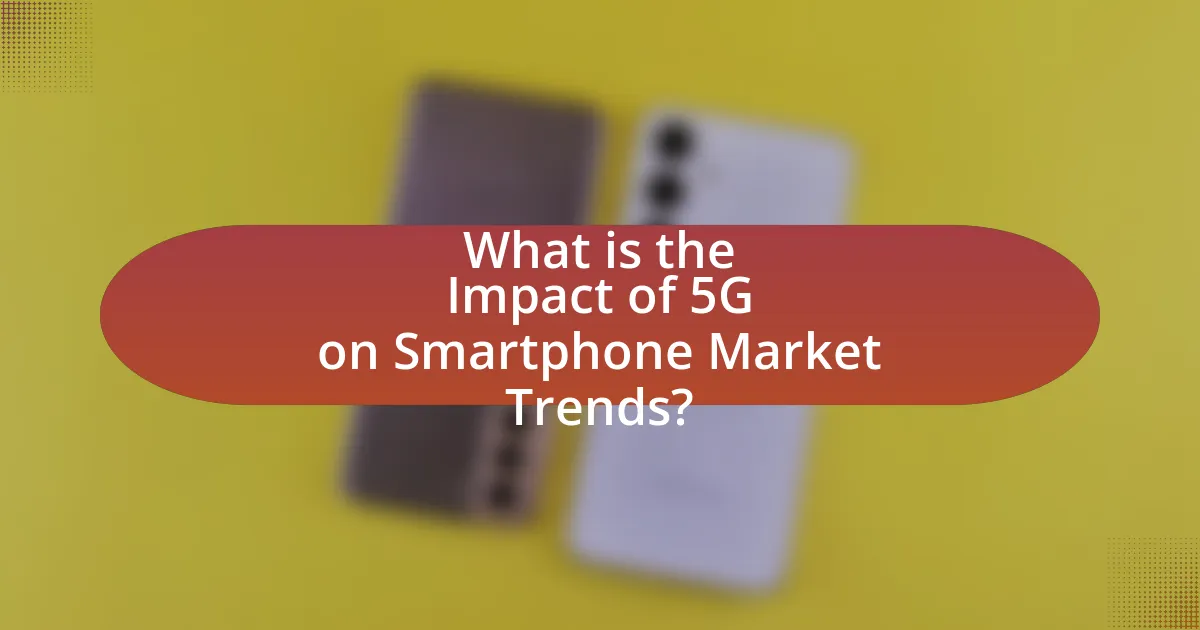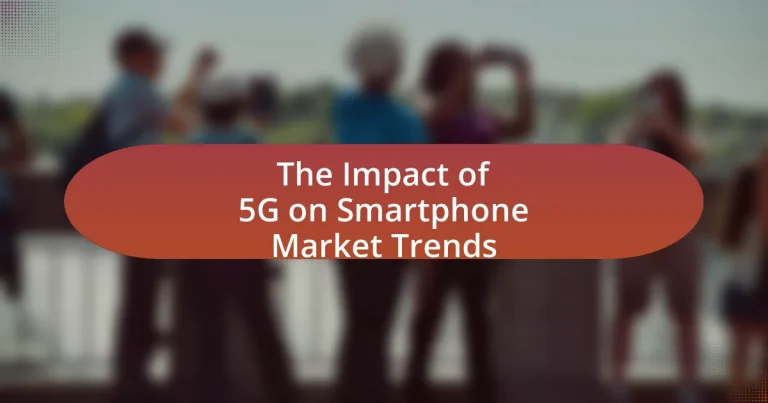The article examines the significant impact of 5G technology on smartphone market trends, highlighting the increasing demand for 5G-compatible devices and the resulting shifts in consumer purchasing behavior. It details how 5G influences smartphone design, features, and performance, including enhanced data speeds and connectivity, while also addressing challenges manufacturers face in the transition to 5G. Additionally, the article explores consumer expectations, pricing strategies, and the competitive advantages gained by manufacturers, as well as future trends in smartphone technology driven by 5G capabilities. Overall, it provides a comprehensive overview of how 5G is reshaping the smartphone landscape.

What is the Impact of 5G on Smartphone Market Trends?
The impact of 5G on smartphone market trends is significant, driving increased demand for compatible devices and influencing consumer purchasing behavior. As 5G technology offers faster data speeds, lower latency, and improved connectivity, manufacturers are prioritizing the development of 5G-enabled smartphones. According to a report by Counterpoint Research, 5G smartphone shipments are projected to reach over 1.5 billion units by 2025, accounting for more than 50% of the global smartphone market. This shift is prompting brands to innovate and differentiate their offerings, leading to a competitive landscape focused on advanced features that leverage 5G capabilities.
How does 5G technology influence smartphone design and features?
5G technology significantly influences smartphone design and features by necessitating enhanced hardware capabilities and new functionalities. Smartphones now require advanced antennas and chipsets to support higher data speeds and lower latency, leading to designs that accommodate these components, such as larger and more efficient battery systems to handle increased power consumption. Additionally, features like improved camera systems and augmented reality applications are being integrated to leverage the high-speed connectivity that 5G offers, as evidenced by the rise in demand for devices that can support 4K streaming and real-time gaming. This shift is reflected in market trends, where manufacturers prioritize 5G compatibility in their latest models to meet consumer expectations for faster and more reliable mobile experiences.
What new capabilities do smartphones gain with 5G integration?
Smartphones gain enhanced data speeds, lower latency, and improved connectivity with 5G integration. Specifically, 5G technology enables download speeds up to 10 Gbps, significantly faster than 4G, allowing for seamless streaming of high-definition content and quicker app downloads. Additionally, 5G reduces latency to as low as 1 millisecond, which enhances real-time applications such as gaming and video conferencing. Furthermore, 5G supports a higher number of connected devices simultaneously, facilitating the growth of the Internet of Things (IoT) and smart city applications. These advancements position smartphones to deliver richer user experiences and support innovative applications that were not feasible with previous generations of mobile technology.
How does 5G affect battery life and performance in smartphones?
5G technology generally leads to increased battery consumption in smartphones due to its higher data transmission speeds and the need for more power to maintain connectivity. Research indicates that 5G can drain battery life by approximately 20% to 30% more than 4G, particularly when devices are in areas with weak signal strength, as they expend additional energy searching for a stable connection. Performance-wise, 5G enhances download and upload speeds significantly, allowing for smoother streaming and faster data transfer, which can improve user experience but may also contribute to quicker battery depletion during intensive tasks.
Why is 5G adoption crucial for smartphone manufacturers?
5G adoption is crucial for smartphone manufacturers because it enables faster data speeds and improved connectivity, which are essential for meeting consumer demand for advanced mobile experiences. As 5G technology offers download speeds up to 100 times faster than 4G, manufacturers can leverage this capability to enhance features such as augmented reality, high-definition streaming, and real-time gaming. Furthermore, the global 5G market is projected to reach $667 billion by 2026, indicating a significant opportunity for manufacturers to capture market share and drive revenue growth. This shift towards 5G is not just a trend; it is becoming a standard expectation among consumers, making it imperative for manufacturers to adopt this technology to remain competitive.
What competitive advantages do manufacturers gain from 5G?
Manufacturers gain significant competitive advantages from 5G through enhanced connectivity, increased data transfer speeds, and improved operational efficiency. The high-speed, low-latency capabilities of 5G enable manufacturers to implement real-time data analytics and automation in production processes, leading to faster decision-making and reduced downtime. For instance, a study by Ericsson indicates that 5G can increase production efficiency by up to 20% due to its ability to support a larger number of connected devices simultaneously. Additionally, 5G facilitates the adoption of advanced technologies such as the Internet of Things (IoT) and artificial intelligence (AI), allowing manufacturers to optimize supply chains and improve product quality. This technological advancement positions manufacturers to respond more swiftly to market demands and enhances their overall competitiveness in the smartphone market.
How does 5G adoption impact pricing strategies for smartphones?
5G adoption significantly influences pricing strategies for smartphones by increasing production costs and enabling premium pricing models. As manufacturers integrate advanced 5G technology, including more sophisticated chipsets and antennas, the overall cost of production rises. For instance, a report from Counterpoint Research indicates that the average selling price of 5G smartphones is approximately 20% higher than that of 4G devices, reflecting the added value of enhanced connectivity features. Consequently, brands often position 5G models as premium offerings, allowing them to capture higher margins and target consumers willing to pay more for the latest technology. This shift in pricing strategy is evident as major companies like Samsung and Apple have launched flagship models with 5G capabilities at elevated price points, further solidifying the trend.
What are the consumer expectations regarding 5G smartphones?
Consumers expect 5G smartphones to deliver significantly faster data speeds, improved connectivity, and enhanced overall performance compared to previous generations. Specifically, they anticipate download speeds exceeding 1 Gbps, which is crucial for activities like streaming high-definition content and online gaming. Additionally, consumers expect 5G smartphones to support a wider range of applications, including augmented reality and Internet of Things (IoT) functionalities. According to a survey by Deloitte, 70% of consumers indicated that faster internet speeds are a primary reason for their interest in upgrading to 5G devices. This expectation is further supported by the rollout of 5G networks globally, which aims to provide lower latency and more reliable connections, enhancing user experiences across various digital platforms.
How do consumer preferences shift with the introduction of 5G?
Consumer preferences shift significantly with the introduction of 5G, as users increasingly prioritize faster data speeds and enhanced connectivity. This shift is evidenced by a growing demand for 5G-enabled devices, with a report from Counterpoint Research indicating that 5G smartphone sales reached 50% of total smartphone sales in 2022, up from just 10% in 2020. Additionally, consumers are more inclined to seek out features that leverage 5G capabilities, such as improved streaming quality, augmented reality applications, and seamless online gaming experiences. This trend reflects a broader expectation for technology that supports higher performance and greater efficiency, ultimately influencing purchasing decisions in the smartphone market.
What role does marketing play in shaping consumer perceptions of 5G smartphones?
Marketing plays a crucial role in shaping consumer perceptions of 5G smartphones by creating awareness and highlighting the benefits associated with the technology. Through targeted advertising campaigns, marketing emphasizes features such as faster download speeds, improved connectivity, and enhanced user experiences, which influence consumer attitudes and expectations. For instance, a study by Deloitte found that 5G marketing campaigns significantly increased consumer interest, with 61% of consumers expressing a desire to upgrade to 5G devices due to perceived advantages. This demonstrates that effective marketing not only informs consumers but also drives demand by framing 5G smartphones as essential for modern connectivity.
How does 5G affect the overall smartphone market landscape?
5G significantly transforms the smartphone market landscape by driving demand for new devices that support enhanced connectivity features. As of 2023, the global 5G smartphone shipments reached approximately 500 million units, accounting for over 50% of total smartphone sales, indicating a strong consumer shift towards 5G-enabled devices. This transition is fueled by the need for faster data speeds, lower latency, and improved user experiences, compelling manufacturers to innovate and release a wider range of 5G smartphones. Additionally, the rollout of 5G networks has led to increased competition among smartphone brands, pushing them to differentiate their offerings through advanced technologies such as improved camera systems and AI capabilities, further reshaping the market dynamics.
What challenges do manufacturers face in the transition to 5G?
Manufacturers face several challenges in the transition to 5G, including high infrastructure costs, the need for new technology integration, and regulatory hurdles. The deployment of 5G requires significant investment in new equipment and network upgrades, which can strain financial resources. Additionally, manufacturers must integrate advanced technologies such as millimeter-wave antennas and massive MIMO systems, which necessitate specialized knowledge and expertise. Regulatory challenges also arise as manufacturers navigate compliance with varying standards and policies across different regions, complicating the rollout process. These factors collectively hinder a smooth transition to 5G for manufacturers in the smartphone market.
How do supply chain issues impact the rollout of 5G smartphones?
Supply chain issues significantly delay the rollout of 5G smartphones by disrupting the availability of critical components such as semiconductors and antennas. For instance, the global semiconductor shortage, which began in 2020, has led to production halts and reduced output for many smartphone manufacturers, resulting in fewer 5G models reaching the market. According to a report by the Semiconductor Industry Association, the demand for chips has surged, but supply has struggled to keep pace, causing delays in product launches and increased prices. This situation hampers manufacturers’ ability to meet consumer demand for 5G smartphones, ultimately slowing the adoption of 5G technology in the market.
What regulatory hurdles must be overcome for 5G smartphone deployment?
5G smartphone deployment must overcome regulatory hurdles such as spectrum allocation, compliance with safety standards, and international coordination. Spectrum allocation involves securing the necessary frequency bands from government agencies, which can be a lengthy process due to competing interests and existing licenses. Compliance with safety standards requires adherence to guidelines set by organizations like the Federal Communications Commission (FCC) and the International Telecommunication Union (ITU), ensuring that devices do not exceed radiation limits. Additionally, international coordination is essential for harmonizing regulations across countries to facilitate global interoperability and avoid fragmentation in the market. These hurdles can delay the rollout and adoption of 5G smartphones, impacting market trends significantly.
What future trends can we expect in the smartphone market due to 5G?
The smartphone market will see increased demand for devices with enhanced connectivity and speed due to 5G technology. As 5G networks offer significantly faster data transfer rates, smartphone manufacturers will focus on integrating advanced features such as augmented reality (AR) and virtual reality (VR) capabilities, which require high bandwidth. Additionally, the proliferation of Internet of Things (IoT) devices will drive the development of smartphones that can seamlessly connect and control multiple devices, enhancing user experience. According to a report by GSMA, 5G connections are expected to reach 1.7 billion by 2025, indicating a strong market shift towards 5G-enabled devices.
How will 5G influence the development of new applications and services?
5G will significantly influence the development of new applications and services by enabling faster data transfer speeds, lower latency, and increased connectivity for a larger number of devices. These enhancements will facilitate the creation of advanced applications such as augmented reality (AR), virtual reality (VR), and the Internet of Things (IoT), which require real-time data processing and seamless user experiences. For instance, a study by Ericsson indicates that 5G networks can achieve speeds up to 100 times faster than 4G, allowing for more complex and data-intensive applications to be developed. Additionally, the reduced latency of 5G, which can be as low as 1 millisecond, will support applications in critical areas like autonomous driving and remote surgery, where immediate response times are essential.
What innovations in smartphone technology are driven by 5G capabilities?
5G capabilities drive innovations in smartphone technology such as enhanced data speeds, improved connectivity, and advanced features like augmented reality and real-time gaming. The introduction of 5G networks allows smartphones to achieve download speeds exceeding 1 Gbps, significantly reducing latency to as low as 1 millisecond. This technological leap enables seamless streaming of high-definition content and supports applications that require real-time data processing, such as cloud gaming and immersive augmented reality experiences. Furthermore, 5G facilitates the development of Internet of Things (IoT) applications, allowing smartphones to connect and control a wider range of devices efficiently. These advancements are supported by industry reports indicating that 5G technology is expected to contribute over $13 trillion to the global economy by 2035, highlighting its transformative impact on smartphone capabilities.
What best practices should consumers consider when purchasing a 5G smartphone?
Consumers should prioritize compatibility with local 5G networks when purchasing a 5G smartphone. This ensures that the device can utilize the available 5G services effectively. Additionally, consumers should consider the smartphone’s chipset, as newer chipsets typically offer better performance and support for advanced 5G features. Research indicates that devices equipped with Qualcomm’s Snapdragon 888 or similar processors provide enhanced connectivity and efficiency. Furthermore, consumers should evaluate battery life, as 5G usage can drain batteries faster; devices with larger batteries or efficient power management systems are preferable. Lastly, checking for software updates and manufacturer support is crucial, as ongoing updates can improve performance and security over time.




